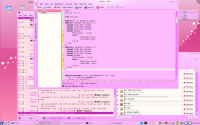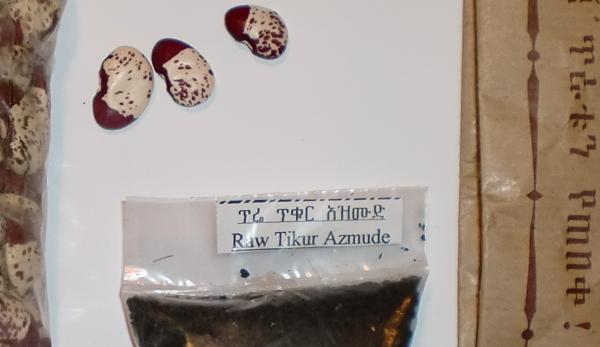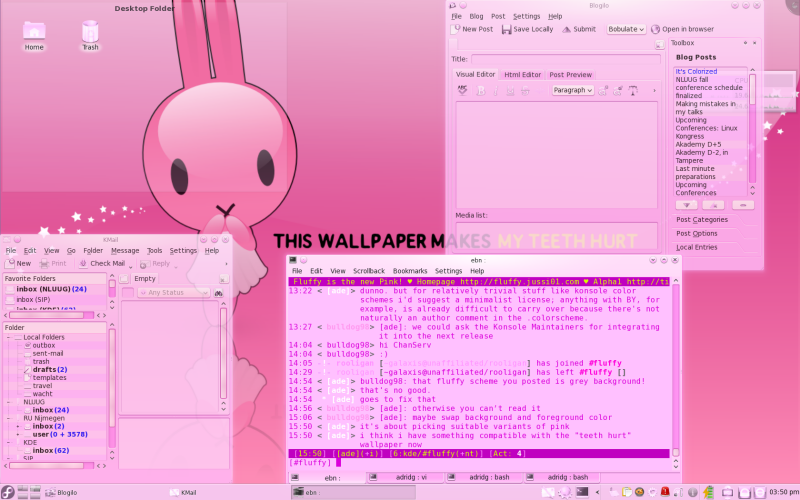Alas, Frederik’s master plan has not seen a whole lot of progress. I wanted to go down that path a little as well — that has everything to do with sitting next to Lydia for a day of not-always-exciting meetings. She challenged me to make my desktop as horrifyingly pink as possible. That would be useful if I had to plug in my laptop to give a presentation: the color scheme would shock everyone awake.
So, clear challenge. Now how do you make your desktop as pink as possible. KDE is terrifically configurable, but that doesn’t mean it’s simple to configure it. Here are my notes in KDE 4.4.5 (Fedora 13). To some extent it’s intended to show where additional polishing might be applied to make KDE more consistent. And overall it will show that for an overall appearance manager we need something more — or something else — than we have right now.
Wallpaper: right click the background of the desktop, pick Desktop Activity Settings. That’s the only configuration item there. It opens a Desktop Settings – Plasma Workspace dialog. Pick Wallpaper. Click Get New Wallpapers. There’s a search bar in the resulting dialog. I tried searching for unicorns first, but the right search term is "Sugarcoma Bunny". Click install and then select that wallpaper, click OK. The dialog goes away and the first step (over one million pixels) in pinkness has been made.
Colors: start System Settings, pick the Appearance module. The title now changes to Style (because that’s the selected item on the left). Go down one item, to Colors. Pick the tab Scheme. Click Get New Schemes. (This Hot New Stuff is really darn useful). Once again there’s a search bar, use "pink". You could pick either Ruphy’s "So pink that it hurts my teeth" or Fregl’s "Fluffy." I think the "hurts my teeth" theme is a little better, but it still needs a little tweaking.
This is where futzing with color schemes gets a little complicated. There is a tremendous number of settings to deal with, and I’m not really sure what all of them do. (Here’s a bit of history related to color display in the scheme list).
Switch to the Colors tab (in the Colors item). From the drop-down box, select Window. Click the button next to Normal Background. Pick a better color. I used #FBBCFF. OK the color dialog, then click apply. For reference, we’re in System Settings – Appearance – Colors – Colors – Window. Five selection levels deep. You might want to Save Scheme to keep these custom settings around, too.
Icons: there doesn’t seem to be a very pink icon set. I skipped this bit for now.
Windows: if you stick with the Oxygen window decoration, there are some additional colors to set. The window shadows are colored as well, and in a pink desktop, you should have pink shadows. I changed the windowdrop-down shadow to use #FBBCFF; the active window glow uses #FF37C7 and outer color #FFC0FF.
Other appearance items: to be truly pervasively pink, we would need a pink splash screen and emoticon set as well. Switch to the Splash Screen item. Click Get New Themes. For some reason this dialog is different from the ones used earlier. It’s titled Get Hot New Stuff and labeled internally with System Settings Add-On Installer. There’s probably some string not being passed to a constructor there to make the labels more meaningful. Note to self: check same dialogs in KDE 4.5.2, then file a bug report if necessary. Searching for "pink", "bunny" and "fluffy" didn’t yield anything, so we’ll have to leave the splash for now; same for emoticons.
[[ By now the desktop is pretty darn pink. But let’s start two applications to see how far the colors go. ]]
Konsole: start Konsole, go to Settings -> Edit Current Profile. Select the Appearance tab. Notice the extremely cool way color schemes slide in, but there’s no quick way to import a color scheme. The New button gives you basically a bunch of color selectors; there’s no Hot New Stuff here, nor a quick way to import settings. It’s not clear to me how to export the settings either — I’ll file a wishlist item there.
It’s straightforward to set up light and dark pink (or purple) as foreground and background colors, but the other available colors are a bit problematic. I use irssi in screen a lot, and the blue and yellow that it uses was a bit jarring. Since I don’t use any other colors in konsole, I just picked a bunch of settings to colorize things in a nice way for my specific use. KDE 4.5 note: seems that the menus have changed a little, and you need to go through the settings dialog.
Kate: the other application I use a lot is Kate, and it uses its own color schemes. Go to Settings->Configure Kate and then under Editor Component / Fonts & Colors you can mess with the colors. Again, no clear way to export a scheme or use Hot New Stuff to get new ones. Here again there’s a huge number of colors to set up (which might explain why there’s only two color schemes by default). I took a quick route to setting up a pink scheme and changed only the four text background colors: normal, selected, current and bookmark = ( #FFBBFD, #FF7DCB, #F8E0F4, #FF39F9). The current line is perhaps a bit greyish, but that does make it easy to spot. I haven’t touched any of the syntax highlighting.
Other UI elements: text input and some other backgrounds still aren’t pinkish, but white. I may have missed something in the color scheme control module. Similarly alternating colors in lists aren’t pink and pink, but still while and blueish.
Plasma Theme: many Plasma themes are dark-ish. For this color scheme, you really want the desktop background to shine through. I tried the Glassified theme but struggled to get it to be transparent. I suspect XRender problems on this laptop. In any case, to change this: System Settings -> Appearance -> Style. Select tab "Workspace". Here you can pick themes. The obvious theme would be the original Fluffy Bunny, but it has gone missing again. I ended up with the Atelier theme — click Get New Themes, then search for that name. Install, apply, done.
 After all this configuration, the desktop looks like the screenshot here. There’s still some disconcerting bits of white there — the open documents list in Kate in particular. But let’s take a step back and summarize where changes needed to be made to achieve the goal of "make it pink".
After all this configuration, the desktop looks like the screenshot here. There’s still some disconcerting bits of white there — the open documents list in Kate in particular. But let’s take a step back and summarize where changes needed to be made to achieve the goal of "make it pink".
Wallpaper, system color scheme, icon set, emoticons, window deco settings and colors, konsole color scheme, kate color scheme, plasma theme. Less than half of these support Hot New Stuff. They are in several different locations, different KCM’s, require manual configuration in applications.
Now suppose that one of my new friends from Ljubljana were to come over and ask if they can make their desktop look like mine (o horrors!). It strikes me that it would be useful to have a new collection (or meta-HNS) setting that is called "Overall Appearance" or something like that that would apply a theme, wallpaper, color scheme, etc. etc. in one go — including Konsole and Kate’s default schemes. Then the idea of "share my desktop look" can come to fruition. Or have I just missed something obvious to do that already?


 After all this configuration, the desktop looks like the screenshot here. There’s still some disconcerting bits of white there — the open documents list in Kate in particular. But let’s take a step back and summarize where changes needed to be made to achieve the goal of "make it pink".
After all this configuration, the desktop looks like the screenshot here. There’s still some disconcerting bits of white there — the open documents list in Kate in particular. But let’s take a step back and summarize where changes needed to be made to achieve the goal of "make it pink".